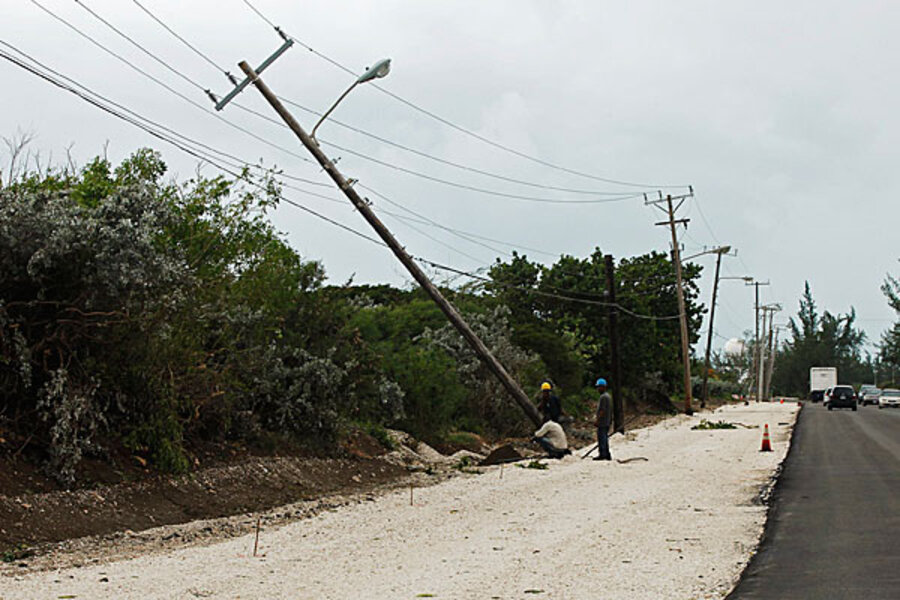East Coast utilities prep for Hurricane Sandy aka 'Frankenstorm'
| Hartford, Conn.
Utilities and governments along the East Coast are working to head off long-term power failures as forecasters predict Hurricane Sandy, a major hybrid storm, to hit a region already skittish after foul weather in recent months that plunged residents into darkness for weeks.
Power companies from the Southeast to New England are telling independent contractors to be ready to help fix storm damage quickly and are asking employees to cancel vacations and work longer hours.
"Although we are not certain the storm will impact the state, we need to be prepared," Connecticut Gov. Dannel P. Malloy said Thursday. "That means everyone, especially the state's utility companies."
RECOMMENDED: Five ways to prep for a hurricane
Federal and private weather forecasters say there is a good chance much of the coast will get hit with gale-force winds, heavy rain, flooding and maybe even snow early next week through Halloween on Wednesday. Hurricane Sandy, now in the Caribbean, is expected merge with a winter storm and a blast of artic air, creating what forecasters are branding "Frankenstorm."
In Delaware, Delmarva Power has activated its emergency teams and is going through checklists to ensure it has sufficient manpower and resources to respond to power outages, including vehicles, cables and poles. The Delaware Electric Cooperative is taking similar steps.
Several storms in the region cut power off for extended periods in the past year or so, including Tropical Storms Irene and Lee in the summer of 2011, a freak Halloween snowstorm last year and violent weather in the mid-Atlantic region in June this year.
Connecticut was among the hardest-hit states last year when Irene and the snowstorm knocked out power to more than 800,000 homes and businesses in the state. Some were without electricity for more than a week after both storms.
State regulators harshly criticized Connecticut Light & Power for a "deficient and inadequate" response. The company's president, Jeffrey Butler, resigned in November.
The company, which serves more than 1 million customers in the state, has worked to improve communications with city officials and between company crews and out-of state workers, CL&P spokesman Mitch Gross said.
The company has already put independent contractors on notice to be prepared next week, and had already increased its tree-trimming budget this year to try to prevent outages as snow-laden limbs crash onto power lines.
Jeff Zizka, 61, of Windham, retired in 2006 after 38 years as a lineman with CL&P. He is planning to have plenty of drinking water on hand, as well as gas for his generator.
"Thank God I'm retired," he said. "Everything sounds like it's going to be pretty bad."
Bob and Cathy Osiecki, retired teachers from Portland, Conn., stocked up on water, flashlights and batteries at a Home Depot in nearby Glastonbury in case their power went out again.
"After last year, everyone is just nervous," Cathy Osiecki said. "We'll have to wait and see. We can always use the water, always use the flashlights."
In Vermont, the Vermont Agency of Agriculture is advising farmers to harvest crops still in the fields. For those who need power for milking cows or cooling milk tanks, the agency warns to prepare for power outages by making sure generators are working.
Farmers also are advised to purchase sufficient fuel to operate generators and equipment.
In New Jersey, where the storm is expected to come ashore, Jersey Central Power & Light has told employees to be prepared for extended shifts. The utility was criticized for its response to Irene.
In Massachusetts, Gov. Deval Patrick has given utilities until Friday to submit plans for the storm. When asked during Thursday on WTKK-FM whether utilities would be ready, Patrick responded, "They'd better be."
The Rhode Island Emergency Management Agency says residents should get ready by clearing gutters, securing outdoor furniture, trimming overgrown tree branches and shrubs and clearing storm drains.
New York Mayor Michael Bloomberg on Thursday noted some uncertainty in the forecasts and said the city was striking a tone of calm preparedness.
"What we are doing is we are taking the kind of precautions you should expect us to do, and I don't think anyone should panic," Bloomberg said. The city has opened an emergency situation room and activated its coastal storm plan.
Baltimore Gas and Electric Co. is putting workers on standby and making plans to bring in crews from other states. So is PPL Corp. in Pennsylvania. In western Maryland, Potomac Edison is denying new vacation requests until storm repairs are made.
RECOMMENDED: Five ways to prep for a hurricane
____
Contributing to this report were Associated Press writers Mark Pratt in Boston, Michael Rubinkam in Harrisburg, Pa., and Karen Matthews in New York.
Copyright 2012 The Associated Press.






